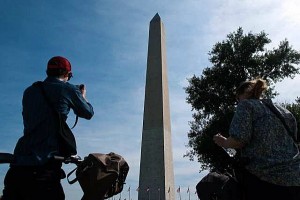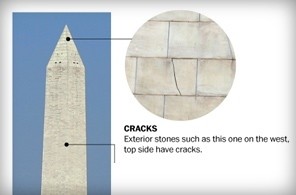 Washington, DC- The National Park Service said Monday that the Washington Monument will be closed indefinitely and that the 5.8-magnitude earthquake in August had done more damage to it than had been previously disclosed.
Washington, DC- The National Park Service said Monday that the Washington Monument will be closed indefinitely and that the 5.8-magnitude earthquake in August had done more damage to it than had been previously disclosed.
Officials said a “debris field,” made up mostly of mortar that had fallen during the quake, had been found at the base and that more substantial pieces of stone had fallen loose inside the monument.
The Park Service posted a video on its Web site taken from a security camera in the observation deck near the top during the quake. It shows debris falling from the ceiling, the entire structure shaking violently, and terrified visitors falling and running for safety.
Mall superintendent Bob Vogel said there were no injuries.
In addition, officials said, the elevator was damaged, possibly by its counterweights, and would need to be repaired. Vogel said the elevator was only partly functional.
Another Park Service official said the elevator could reach only the 250-foot level of the 555-foot-tall monument.
The Park Service had preliminarily said the quake caused some cracks in the stone, which resulted in water leaks when Hurricane Irene came through Washington a few days after the quake.
A team of engineers planned to start a block-by-block inspection of the exterior Tuesday while suspended by ropes. An inspection of the interior is finished, Vogel said.
He said the worst damage happened in the pyramidium, the pyramid-shaped top of the structure, where cracks up to 11 / 4 inches wide developed in the mortar and stone. “Daylight is visible at a number of the vertical joints where mortar is missing,” he said.
As a result, a substantial amount of water has been getting into the monument, which could cause more damage.
 It is the extent of damage to the exterior that must now be assessed, he said.
It is the extent of damage to the exterior that must now be assessed, he said.
The engineers, from Wiss, Janney, Elstner Associates’ “difficult access team,” are specially trained and equipped to rappel down the four sides of the monument. They will examine each of the marble exterior stones for damage.
Officials said the rappelling operation, in which engineers are harnessed in small seats hung from ropes, would last about five days. They hoped to have a more in-depth assessment of the monument by next month.
To assist the engineering team, the Park Service has brought in Brandon Latham, a mountaineering and rope-rigging ranger, from Denali National Park in Alaska.
Dan Gach, 35, one of the rappelling engineers, said each engineer will take one side. He said the team has a detailed description of each stone, which was compiled during the 1999 rehabilitation project.
He said the engineers have drawings of each of the marble exterior stones so they can compare its 1999 condition with the present one. Each stone is numbered.
The engineers also have small hammers they can use to test the soundness of the stones, he said.
“You can tap it lightly, and the stone density will make a definitive sound,” he said. When you tap a weak spot, “that area will just sound dead.”
The team will use strong, specially coated nylon rope, and a supervisor will use a meter to monitor the wind velocity, he said. Winds of 25 mph are considered unsafe for the team.
Vogel said the team will climb out the windows near the top of the monument, maneuver with ropes up to the peak and then work its way down. The climbers will remove any loose material they find if they can do so safely and by hand, Vogel said.
Weatherization of the open cracks will take place after that, he said.
“So when is the monument going to reopen?” Vogel said. “Unfortunately, we cannot answer that question.” He said that once the extent of the damage is learned, the Park Service can develop a timeline for repairs and reopening.
The Park Service has spent a little more than $200,000 on the inspection. It is not known how much the repairs will cost.
The monument has been closed since the earthquake struck. Bill Line, a Park Service spokesman, said the quake caused only minor damage to the Lincoln and Jefferson memorials.
“The good news: The monument is structurally sound and is not going anywhere,” Vogel said during a news briefing Monday on the Mall across 15th Street from the towering obelisk.
After the earthquake, some damage was linked to the soft mortar inserted between stones during a renovation that began in 1999.
That mortar was designed to crumble, to give the structure flexibility, the Park Service has said.
Repairs were made on some cracks after Hurricane Irene, and puddles were found inside the monument. Experts wondered where there were more, undetected cracks.
The puddles were discovered in stairwells above the 400-foot level.
Meanwhile, Washington National Cathedral is using a new construction crane to resume repairs of earthquake damage to its central tower, spokesman Richard Weinberg said Monday. The massive cathedral in Northwest Washington also has been closed since the earthquake.
A crane brought in for earthquake-related repairs toppled over Sept. 7, injuring its operator and damaging buildings days before the cathedral was set to reopen.
The cathedral was not damaged in the incident, but the building has not been able to reopen, Weinberg said. Two cranes were brought in to help remove the toppled one, and one crane stayed to resume the repairs, he said.
